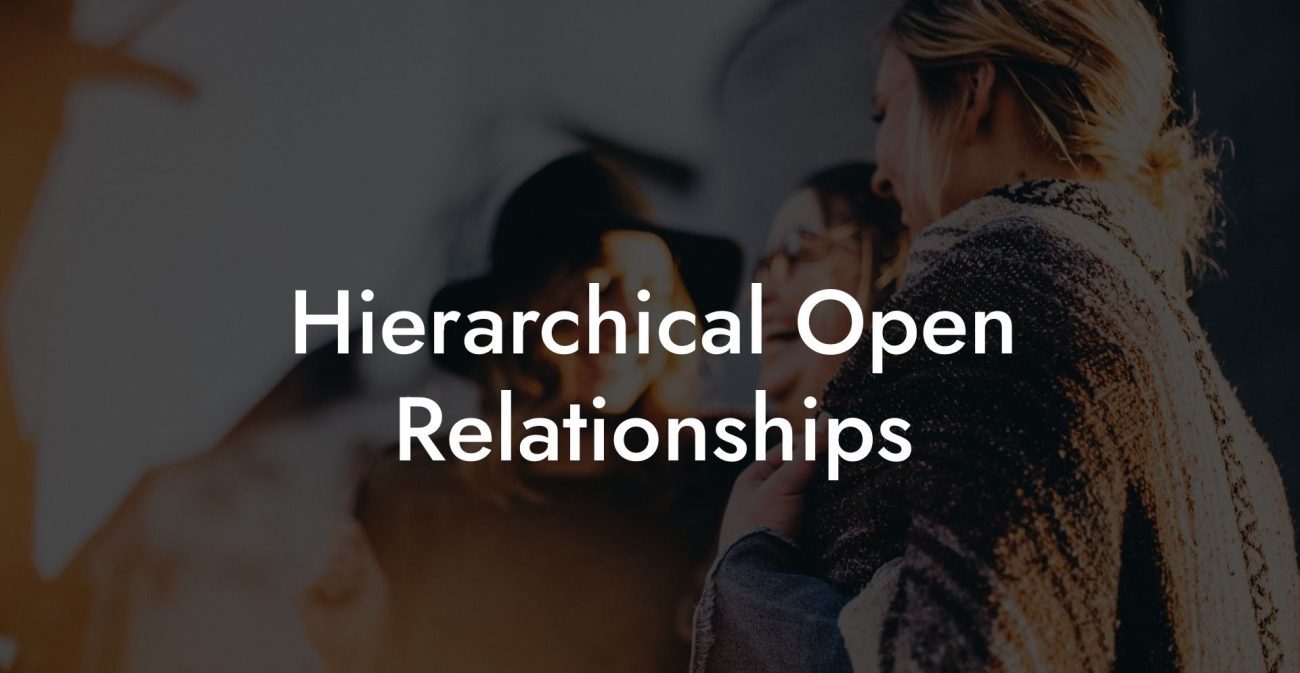Tertiary Partner

Picture a hidden gem in a vast treasure trove, a relationship that’s not in the spotlight like your primary connection, yet shines with its own unique brilliance. Welcome to the guide on Tertiary Partner, where we explore the role, benefits, challenges, and practical strategies for nurturing relationships that are an important, though less central, part of your intimate network. Whether you’re part of a non-monogamous setup or simply curious about adding another dimension to your relationship spectrum, this guide will help you understand and appreciate the value of a tertiary partner.
Quick Links to Useful Sections
- Understanding Tertiary Partners
- Defining the Tertiary Partner
- The Role and Significance of a Tertiary Partner
- Complementary Support and Variety
- Supporting Personal Autonomy
- Benefits of Tertiary Partnerships
- Diverse Perspectives and Emotional Enrichment
- Low-Pressure Intimacy
- Opportunities for Personal Growth
- Flexibility and Spontaneity
- Challenges of Tertiary Partnerships
- Perceptions of Being “Less Important”
- Time and Energy Constraints
- Communication Complexities
- Social Stigma and External Judgments
- Strategies for Nurturing Healthy Tertiary Partnerships
- Maintain Clear, Open Communication
- Set and Revisit Boundaries
- Utilize Digital Tools for Coordination
- Invest in Self-Care and Personal Growth
- Build a Supportive Network
- Be Flexible and Adaptable
- Integrating Tertiary Partnerships with Your Overall Relationship Network
- Clarifying Roles and Expectations
- Collaborative Communication
- Real-Life Success Stories
- Case Study: Riley’s Journey to Balance
- Case Study: Jamie’s Experience of Empowered Connection
- Expert Insights on Tertiary Partnerships
- FAQ: Your Tertiary Partner Questions Answered
Understanding Tertiary Partners
Defining the Tertiary Partner
A tertiary partner is someone with whom you share a meaningful connection that, while significant, does not receive the same level of emotional, time, or logistical investment as a primary or secondary partner. In many non-monogamous relationships, the primary partner is the central pillar, the secondary partner offers additional emotional support or excitement, and the tertiary partner provides a more flexible, often more casual connection. This relationship can be sexual, romantic, or a blend of both, but it is characterized by its lower degree of integration into your daily life.
Importantly, labeling a connection as “tertiary” is not about devaluing it, it’s about clarifying the different roles each relationship plays in your life. A tertiary partner may offer novelty, creative inspiration, or occasional intimacy, enriching your overall relational experience without the weight of intensive, long-term commitment.
The Role and Significance of a Tertiary Partner
Complementary Support and Variety
Tertiary partners often bring diversity and spontaneity into your relational ecosystem. They can provide a refreshing change of pace and a different perspective on life, complementing the stability of your primary and secondary bonds. Whether it’s a spark of intellectual conversation, a fun social outing, or occasional physical intimacy, tertiary connections add layers of variety and excitement.
In many cases, tertiary partnerships serve as outlets for exploring different facets of your personality. They may be the friends who also become lovers, or connections that focus primarily on sexual or intellectual exploration. Their role is flexible and often less structured, giving you room to experiment and grow without overwhelming your core emotional reserves.
Supporting Personal Autonomy
One of the beauties of tertiary partnerships is that they encourage personal autonomy. With fewer obligations and lower levels of integration, these relationships allow you to maintain a strong sense of self while still experiencing connection and intimacy. This independence can lead to greater self-awareness, as you learn more about your desires and boundaries in a context that doesn’t demand total emotional immersion.
Benefits of Tertiary Partnerships
Diverse Perspectives and Emotional Enrichment
Tertiary partners can offer fresh insights and emotional support that differ from what you experience in your primary or secondary relationships. Their distinct personality and life experiences can challenge you to think differently, add excitement, and enhance your overall emotional well-being.
Low-Pressure Intimacy
Because tertiary relationships typically involve fewer obligations, they often come with lower emotional pressure. This can make them an ideal space to experiment with different forms of intimacy, be it casual sexual encounters, intellectual discussions, or light-hearted companionship, without the expectation of deep, lifelong commitment.
Opportunities for Personal Growth
Engaging with a tertiary partner encourages you to reflect on what you truly need from your relationships. It can help you identify your personal boundaries and develop effective communication strategies. This self-exploration not only benefits your tertiary connection but also enriches your primary and secondary relationships.
Flexibility and Spontaneity
Tertiary relationships offer flexibility, allowing you to explore connections that are spontaneous and evolving. They provide a space where you can embrace new experiences and change without the constraints of heavy commitment. This fluidity can be both liberating and empowering, contributing to a well-rounded and dynamic love life.
Challenges of Tertiary Partnerships
Perceptions of Being “Less Important”
One common challenge in tertiary partnerships is the potential for feelings of inadequacy or insecurity. Because these connections are, by definition, less integrated than primary relationships, there may be a risk of feeling undervalued or overlooked. It is important to address these feelings openly to ensure that every partner feels respected and valued.
Time and Energy Constraints
Balancing time among multiple relationships can be tricky. With a primary partner often taking up a significant portion of your emotional and practical energy, it can be challenging to allocate sufficient time for a tertiary partner. This can lead to feelings of neglect if expectations are not clearly communicated.
Communication Complexities
In any multi-partner arrangement, effective communication is key. For tertiary relationships, where expectations may be less defined, miscommunication can easily occur. It’s crucial to establish clear boundaries and keep the lines of communication open to prevent misunderstandings.
Social Stigma and External Judgments
Tertiary partnerships may also be subject to social stigma or misconceptions about non-traditional relationships. Friends, family, or society at large might undervalue these connections, leading to external pressures that can impact your self-esteem and relationship dynamics.
Strategies for Nurturing Healthy Tertiary Partnerships
Maintain Clear, Open Communication
The foundation of any healthy relationship is communication. Set aside regular check-ins, either one-on-one or within the context of your overall relationship network, to discuss your feelings, expectations, and any changes that may occur. Use “I” statements to express your needs and encourage your tertiary partner to do the same.
Set and Revisit Boundaries
Establish clear boundaries regarding time, emotional investment, and physical intimacy early on. Document these agreements using digital tools such as shared notes or calendars, and review them periodically to ensure they still reflect your current needs. This ongoing negotiation helps prevent misunderstandings and keeps everyone on the same page.
Utilize Digital Tools for Coordination
Leverage digital calendars, scheduling apps, and messaging platforms to coordinate time with your tertiary partner. This not only helps manage your overall schedule but also ensures that each connection receives the attention it deserves.
Invest in Self-Care and Personal Growth
Prioritize your own well-being by engaging in regular self-care practices, such as exercise, meditation, or creative hobbies, and encourage your tertiary partner to do the same. Self-reflection through journaling or therapy can help you understand your emotional needs and manage any insecurities that may arise.
Build a Supportive Network
Connect with others who understand and navigate non-traditional relationship structures. Join online communities, social media groups, or local meet-ups dedicated to ethical non-monogamy. A supportive network can provide validation, advice, and a sense of belonging that enriches your tertiary relationship.
Be Flexible and Adaptable
Recognize that the dynamics of a tertiary partnership can evolve over time. Stay open to renegotiating boundaries and adjusting the level of commitment as your needs and circumstances change. Flexibility is key to ensuring that your tertiary connection remains fulfilling and does not become a source of stress.
Integrating Tertiary Partnerships with Your Overall Relationship Network
Clarifying Roles and Expectations
In a multi-partner system, it’s important to clearly distinguish between the roles of primary, secondary, and tertiary partners. Clarify expectations regarding emotional investment, time commitments, and boundaries for each relationship. This clarity helps prevent conflicts and ensures that every partner feels valued.
Collaborative Communication
Encourage discussions that include all involved partners when necessary, as well as individual conversations. A collaborative approach to managing your relationship network can lead to more effective conflict resolution and a stronger sense of community.
Real-Life Success Stories
Case Study: Riley’s Journey to Balance
Riley, who has maintained a tertiary relationship alongside a primary and secondary partner, found that clear communication and regular boundary reviews were the keys to success. By setting aside dedicated time for individual check-ins and using a shared digital calendar, Riley ensured that all partners felt heard and valued. This approach allowed for a fluid yet stable connection that enriched Riley’s overall emotional landscape.
Case Study: Jamie’s Experience of Empowered Connection
Jamie experienced personal growth through a tertiary partnership that started casually but evolved into a supportive, meaningful connection. Open dialogue about expectations and needs, along with regular self-reflection, helped Jamie navigate moments of insecurity. The positive impact on Jamie’s self-awareness and emotional well-being ultimately enhanced all aspects of their relationship network.
Expert Insights on Tertiary Partnerships
Relationship experts emphasize that tertiary partnerships, when managed with clear communication and healthy boundaries, add valuable diversity to your relational network. Dr. Elena Rivera, a therapist specializing in non-monogamous dynamics, explains, “Tertiary relationships can be a vital source of creativity, support, and exploration. Their success lies in ensuring that every partner understands their role and that open communication is maintained.”
Relationship coach Marcus Lee adds, “Embracing a tertiary connection means appreciating that every relationship contributes something unique. With flexible boundaries and ongoing dialogue, tertiary partners can enrich your life without overwhelming your primary connections.”
FAQ: Your Tertiary Partner Questions Answered
1. What is a tertiary partner?
A tertiary partner is an individual with whom you share a meaningful, yet less central, connection compared to your primary and secondary partners. They provide additional support and intimacy on a more flexible, often less intensive basis.
2. How does a tertiary partner differ from primary and secondary partners?
While a primary partner is the central focus of long-term commitment and a secondary partner holds a significant, supportive role, a tertiary partner offers additional connection and variety without being as integrated into your daily life.
3. What benefits do tertiary partnerships offer?
Tertiary partnerships provide diverse emotional support, opportunities for personal exploration, and a flexible form of intimacy that can add richness to your overall relational network.
4. Can tertiary relationships exist in both monogamous and non-monogamous contexts?
Tertiary relationships are most commonly discussed in non-monogamous contexts, but similar dynamics can sometimes be seen in monogamous relationships through close friendships or supportive external connections.
5. How do I ensure that a tertiary partner feels valued?
Through regular, honest communication, clear boundary-setting, and by making time for meaningful interactions, you can ensure that your tertiary partner feels appreciated and respected.
6. What challenges might arise with tertiary partnerships?
Common challenges include feelings of being undervalued, managing time effectively, and navigating potential jealousy or miscommunication about the nature of the connection.
7. How important is communication in managing a tertiary relationship?
Communication is crucial. Regular check-ins and open dialogue help clarify expectations and ensure that all partners feel secure in their roles.
8. How can digital tools help in managing tertiary relationships?
Digital tools like shared calendars, scheduling apps, and digital journals can help coordinate time and maintain consistent communication, ensuring that your tertiary partnership is well-integrated with your other relationships.
9. What strategies can help manage jealousy in tertiary relationships?
Address jealousy by using “I” statements, engaging in self-reflection, and maintaining open conversations with all partners. Professional support, such as counseling, can also be helpful if jealousy becomes overwhelming.
10. Where can I find more resources on tertiary partnerships?
Look for books like "The Ethical Slut" and "More Than Two", podcasts such as “Multiamory,” and join online communities on Reddit and Facebook dedicated to ethical non-monogamy for further insights.
Resources and Community Support: Your Next Steps in Exploring Tertiary Partnerships
- Books: Begin with foundational texts like "The Ethical Slut" and "More Than Two" to understand the dynamics of multiple relationships.
- Podcasts: Listen to "Multiamory" and similar shows to hear personal stories and expert insights on managing tertiary connections.
- Online Communities: Join forums and social media groups dedicated to ethical non-monogamy, such as Reddit’s r/polyamory and related Facebook groups.
- Workshops and Webinars: Attend events focused on communication, boundary-setting, and relationship management to enhance your skills.
- Therapy and Counseling: Seek guidance from relationship therapists who specialize in non-monogamous dynamics for personalized advice.
Embracing a tertiary partnership is about celebrating the unique, enriching role it plays in your broader relational network. With open communication, clear boundaries, and a commitment to personal growth, you can nurture a connection that adds depth and diversity to your journey of love.
Lost & confused by all of the terms, types and seemingly made up 3 letter acronyms?? We've got you. Check out our Ethnical Non-Monogamy Dictionary >>
Useful Interruption: Not sure which relationship vibe fits you best? Take our Relationship Test, it’ll give you the real insight into your natural relationship style. Then, dive into our binge-worthy guides (from the tried-and-true to the “wait, that’s a thing?”) and find the perfect relationship type for your life:
- Monogamy
- Open Relationships
- Ethical Non-Monogamy
- Solo Polyamory
- Non-Hierarchical Polyamory
- Hierarchical Polyamory
- Relationship Anarchy
- Swinging
Now back to the main article but yeah take the test...












